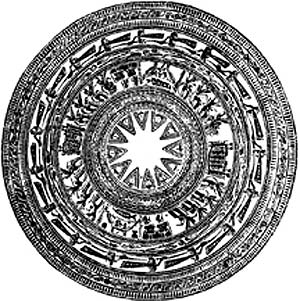
Pages 5, 6.

Fig. 2. Tympanum of a bronze drum depicting human figures, birds, and geometric designs. (After Wen Yu.)
Migrations
Present-day South-East Asia is an anthropologist's delight. This corner of the world is remarkable for its incredible diversity of ethnic groups, each of which has its own language, customs, mores, and religious beliefs.
Historians and archaeologists are in general agreement that modern South-East Asia was not peopled by descendants of Java Man, a hominid species that ranged from Africa up to the glacial boundaries of Europe and all the way to China. It would appear that Java Man died after failing to adapt to a changing environment. It is also possible that he was pushed out or destroyed by a more advanced species. 17
Scholars concur that the peopling of South-East Asia occurred through a series of southward migrations from the Asian mainland. The origins, the routes taken, the precise points in time of these various movements, and their extent and relationship to various archaeological remains of South-East Asia, have all stimulated lively debate.
South-East Asia today has a sprinkling
of hunting gathering Negrito people, such as the Aeta of the Philippines,
the Semang of Malaysia, and the Orang Kubu of Sumatra. Living in family groups
in isolated localities, these people are considered descendants of the earliest
existing inhabitants of South-East Asia. Shunning contact with other groups,
they sleep in tree or rock shelters and live off jungle fruits, roots, and game
or fish caught with bows and arrows or ingenious traps.18 Clothing is minimal
and is made from bark, leaves, and grasses found in the forests. Weaving does
not seem to be an important activity amongst these people.
Australoid peoples are also thought to have passed through South-East Asia during
the early migration period.
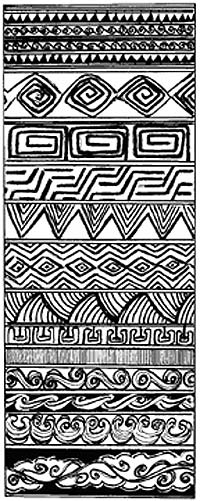

Fig. 3. Patterns seen on bronze drums found in South China and South-East Asia. (After Wen Yu.)
Although no longer evident as a racial entity, traces of these people may be seen in the current racial stock of Timor and Flores. Vestiges of Melanesoid peoples have also been found amongst the Senoi in Malaysia, the Alfurs of the Moloccas, and on the Engano and Mentawi Islands off the south coast of Sumatra. 19
The majority of the present-day indigenous population of South-East Asia are basically mongoloid, consisting of various peoples who migrated from South China and the Tibetan border areas at various times. The earliest arrivals, sometimes called Proto-Malay or Nesiot, are thought to have come around 2500-1500 BC in a series of drawn-out migrations. They were a Stone Age people who were hunters, cultivators, fishermen, and sailors. They built houses and boats. They were also skilled potters and adorned themselves with elaborate jewellery. As ancestor worshippers, they were preoccupied with notions of death, renewal, and fertility. The continued well-being of the community was all important. Megalithic monuments in the form of dolmens and menhirs remain as a testimony to their complex religious beliefs. In their art, images of ships, trees of life, ancestor figures, and sacred animals are commonly depicted.
Descendants of these people possibly include the Jakun of Malaysia, the Bataks of Sumatra, the Dayaks of Borneo, the Toradja of Sulawesi, the Igorot tribes of the northern Philippines, and some Montagnard groups of central Vietnam. Many of these people have a time-hallowed tradition of making cloth from bark. Some are also among the most outstanding weavers still at work in South-East Asia today. Using a simple body-tension loom and the warp ikat patterning technique, these people have created a remarkable range of textiles. The motifs offer a tantalizing glimpse into the world view of these ethnic groups. It is not known whether these people brought the art of weaving to South-East Asia, or whether they acquired it later through contact with more advanced cultures.
On arrival, these mongoloid people, in all probability, pushed the earlier Negrito into the interior uplands. In turn, they were forced by later invasions of more advanced peoples to vacate the lowland areas and seek their livelihood in the mountainous interiors and on the more remote islands, where they remain to this day. The later arrivals (sometimes called Deutero-Malay) include the present-day Malay population of Malaysia, Indonesia, and the Philippines, the Mons of Burma and Thailand, and the Khmers and Cham of lowland Indo-China. The Annamese of Vietnam, the Tibeto-Burmese peoples, and the numerous branches of the Thai race are thought to have arrived in South-East Asia in separate migrations at a later date.
The earliest arrivals of the Deutero-Malay group were neolithic peoples who had an advanced culture. They grew rice, used bamboo pipes for irrigation, and harnessed the buffalo to draw the plough. They were skilled woodworkers, had a rudimentary knowledge of metals, and were skilled navigators. They lived in matriarchal societies in organized village communities with simple laws.20 They were animist in their beliefs and worshipped the ancestors. They certainly knew the art of weaving and could have passed it on to the less-advanced inhabitants of their new lands.
Pages 28-31
Indigo
The most important and well-known dye throughout South-East Asia is indigo, which is derived from a 1 m high shrub with light, feathery leaves (Fig. 25). This dye has been used in China since ancient times. In South-East Asia, it has long been an important export item, at one time ranking immediately behind spices and aromatic woods in importance. Throughout the seventeenth and eighteenth centuries, it was Indonesian indigo which coloured the clothes worn by the Calvinist Dutch Burghers. The British, at the same time, carried on a very profitable trade in indigo from their Far Eastern possessions.42
Although the making of indigo dye varies in each area in the number of days
for steeping and the quantities of specific additives, the processes and key
ingredients are essentially the same. The most important indigo-producing species
are Indigofera tinctoria and Indigofera anil, which may be cultivated in small
plots or grown wild.43 Three months after planting, the leaves are collected,
pounded, placed in an earthenware jar, and steeped in water for three to ten
days until they disintegrate through fermentation (Fig. 26). To render the dye
soluble in water, slaked lime, in the approximate proportion of 1 : 5 in weight,
is added to the solution. A lye made from wood ashes is also added. Various
substances, such as palm sugar, molasses, and rice whisky, may be introduced
in small quantities to aid fermentation. Local ingredients, such as a dash of
kerosene, banana, cassava, betel, or shredded chicken meat have been known to
have sometimes been included in an effort to procure a better dye colour.
When the solution is ready, the cloth or yarn is completely submerged in the
dye overnight, and then hung out to dry in the sun the following day. This drying
process, after dipping, is necessary to oxidize the dye so as to form the indigo
colour on the fibre. To get the characteristic blue-black shade, the cloth must
be dipped and dried, up to thirty times and rinsed occasionally in fresh water.
The process may take a few weeks to complete, depending on the strength
of the dye solution. With the exception of Indonesia, mordants do not seem to
be widely used for indigo, so the colour tends to
bleed a little in the first few washes until it becomes fixed.44 In some areas
where the indigo plant is
scarce, a dye made from leaves mixed with lime is evaporated to leave a solid blue substance, which may be saved and activated by mixing with water and a lye of ashes. 45
Despite the fact that chemical substitutes, such as aniline dyes derived from
coal tar, and other hydrocarbon sources are readily available, the art
of indigo dyeing using leaves is still quite widespread. To the skilled dyer,
a number of shades, ranging from blue black and royal blue through to light
shades of grey, lavender, and pink, are possible from indigo.46 The women of
Savu and Roti are famous for their distinctive bluish-black indigos, while
Sumba colours its famous ikat with an arresting lighter blue. Indigo is the
most important colour to the hill tribes of South-East Asia. It is the only
dye used by the Hmong, Mien, and Akha, who consider it a most fitting ground
colour for their distinctive batik, embroidery, and applique decoration. Indigo-dyed
clothing is also very popular for everyday wear throughout rural Thailand. In
South-East Asia, indigo is always the first colour to be applied to the yarns.
Red
Red is second in importance to indigo as a colorant and is generally a much more difficult dye to make. A large number of processes and pigments are known for creating red dyes. Depending on the dye substance used, the fibres may require extensive pretreatment to prepare them to accept the dye.
The root bast of the morinda tree (Morinda citrifolia), which contains an alizarin substance, is widely used throughout South-East Asia as a source of red dye capable of producing tones ranging from vibrant red through to deep maroon and chocolate (Fig. 27).47 Known by various names, such as 'turkey red' and mengkudu and kombu in Indonesia, and koh by the hill tribes of Thailand, the knowledge of this dye substance is thought to have originated in the Middle East and spread to India and South-East Asia through Indian and Arab contacts.
The morinda roots are collected, crushed, pounded, and mixed with water. After filtering, a mordant made from the crushed leaves of alumina-bearing plants, such as the Symplocos genus, are added, along with a lye of ashes to improve the solubility of the pigment. The dye is usually boiled in a pot over an open fire for a period of time. So that the dye colour will adhere, the fibres are repeatedly pre-treated with an oily substance mixed with a lye of ashes. Many types of oil are used. The Balinese use coconut, while the people of Nusa Tenggara favour the kemiri nut (candlenut). The Batak people of Sumatra use buffalo lard. The Iban are known to pre-dye their threads with yellow so as to get a particular shade of red. The pre-treatment process may be almost as lengthy as the dyeing process.
The actual dyeing may take many months until the desired shade is achieved. For an ordinary red, the yarn is soaked overnight and dried during the day at least ten times. To achieve a darker hue, the yarn might be dipped and dried over thirty times at three-to-fifteen-day intervals. In the village of Tenganan in Bali, it can take up to six years to achieve a particular highly prized shade of red for ritual cloths.48 In the central and southern Philippines, dyes are applied to the yarns by a steaming process using two earthenware pots, rather like a double boiler. 49
Dyers may be hampered by the availability of raw materials. In the drier areas of Nus a Tenggara where the morinda tree is not prolific, dyers may have to wait until the roots sufficiently regenerate before they can make more dye. 5° On the island of Flores in eastern Indonesia, it may take up to 27 kg of morinda root to produce enough dye for one sarong.51
When boiled with water, the wood shavings of sappan, Caesalpinia sappan L., a low, thorny bush with yellow flowers, produce a red dye which is widely known throughout the area. In the Philippines, after dyeing with sappan, the threads may be cooled in river clay to fix the colour. The seeds of the anatto (Bixa orellana), a South American tree widely grown in the tropics, are dipped in water to produce an orange-red dye which is used in the Philippines, Thailand, and Kampuchea. 52 The weavers of north-east Malaysia at one time made a red dye for silk from the fruit of asam gelugor (Garcinia atroviridis) mixed with tamarind and a pinch of alum. 53 The Iban and Dusun of Borneo make a dye from the resin-coated scales which cover the developing fruit of a species of rattan (Damonorhops didymophyllus) found in the Malaysian and Sumatran forests. In Sabah, the Dusun collect the fruit when ripe and shake the juice and resin into a basket. This liquid is boiled .until it evaporates into a paste which adheres to a stick. This stick is saved and reheated when the dye is required. 54 A similarly coloured substance secreted by the lac insect (Lucifer lacca Ker) is used in Thailand and Burma for making a red dye. The resin-coated twigs are collected, dried in the sun, and then pounded to a powder, which is mixed with an acidic tamarind paste and water. Cotton and silk yarns are submerged in the solution for thirty minutes before being hung to dry. 55 In addition to those mentioned, every country has a number of specific indigenous plants which are known to produce a variety of red dye substances.
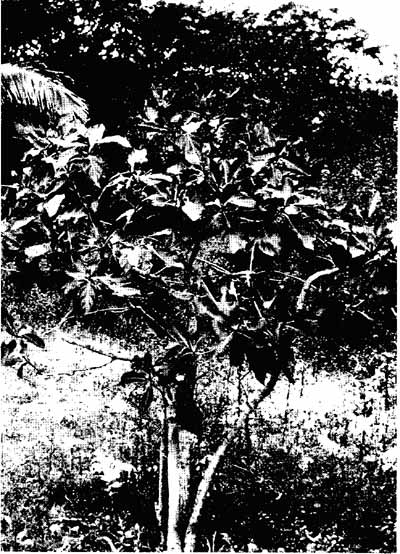
Page 29 Fig 27 - The morinda tree (Morinda citrifolia), the roots of which provide a red dye commonly used throughout South-East Asia. Rende, East Sumba
Other Colours
A large number of plants are known to give yellow dyes. The most important is the turmeric rhizome (Curcuma longa L.), a member of the ginger family which is widely grown throughout South-East Asia. The root is ground to a coarse powder and mixed with water. After filtering, it is ready for use. This dye is readily absorbed by fibres, so a mordant is not always used. 56 Specific substances may be added to alter the characteristic mustard shade. The addition of slaked lime produces an orange hue, while a squeeze of an acidic juice, such as citrus or tamarind, can render the solution bright yellowY The heart- wood of Cudrana javanensis, a spiny shrub, is used in both Thailand and Indonesia to yield a yellow dye. The dye is obtained by soaking chips of heartwood overnight and boiling the following day. After stirring, a mordant is added and the yarns are boiled in the dye. 58
The wood of the jackfruit tree (Artocarpus integrifolia L.) was at one time used exclusively to dye the robes of Buddhist monks in Thailand, Kampuchea, and Burma a particular sober shade of yellow, as prescribed in the Pali Vinaya, a book of rules pertaining to monks. Prior to dyeing, the material for the robes was put in a vat containing a solution prepared from cow dung, red earth, or selected parts of plants, such as rhizomes, roots, bark, wood, flowers, or fruits. The heartwood of the jackfruit was cut into slices or fragments and boiled until the liquid was dark brown in colour. The wet robe was steeped in the solution until a dull yellow was obtained. 59 The Iban also used the jackfruit wood, mixed with an alkali, as a dye. It was also once used with alum as a dye for Javanese batik. 6o The wood of the jackfruit is capable of producing a wide variety of shades, ranging from muddy yellow through to apricot and tan.
The people of Nusa Tenggara are also known to use the bark of the mango tree (Mangifera laurinia) to produce a yellow dye.61 The safflower (Carthamus tinctorius), which has had a long history as a dye in the ancient civilizations of Asia and Africa, probably came to South-East Asia via India. The crushed petals, after being kneaded and stirred in cold water, first yield a yellow dye, which is poured off. The base of the petals produces an acidic red dye, which is neutralized by adding lime as a mordant prior to use.62 Safflower is used as a dye in Indonesia and Thailand. Some dyers in Indonesia also use the dried imported flowers of Saphora japonica to produce a yellow dye. In Burma, the dried stigma of Crocus sativus was at one time used to produce a strong yellow shade.
There are a number of trees which yield brown dyes. The best known in Indonesia is the bark of the soga tree (Pelthophorium ferrungineum), which gives dyes ranging from yellowish tan to deep chocolate brown. It is used to dye Central Javanese batik its soft brown colour. Shavings of bark are boiled in water to produce the dye. As with morinda, the cloth or yarn must be pre-treated with oil prior to dipping many times in a lukewarm dye solution. After dyeing, the fibres are submerged in a lime solution and then in a fixing bath. The latter may include one or more of the following: borax, alum, sugar, and lemon juice. Soga may be mixed with other dyes, such as morinda, to get different shades. 63
The leaves of the teak tree (Tectona grandis) are used to produce a brown-to-red dye in Sumbawa and Sulawesi. 64 The Philippines also has a number of trees which produce strong brown dyes, such as the talisay tree (Terminalia catapa) and the katuray (Sesbania grandifolia).65 A dull brown is obtained from the wood of the ubiquitous betel-nut tree (Areca catechu). The wood is cut into chips and boiled in water to release the dye. The yarn is immersed in the hot liquid for about half an hour for a lighter shade and overnight for a darker hue. This dye is used in Kalimantan and Burma. The coastal communities of South-East Asia have, in the past, used the bark and leaves of the mangrove (Rhizophora mucronata) to get brown-to-black shades. The Iban use its bark and that of the samak tree to get a rich reddish brown colour to dye their distinctive warp ikat.66
Green shades are usually obtained by overdyeing a yellow, such as jackfruit or turmeric, with a weak solution of indigo. In Thailand, the outer pulp of pineapple leaves and the leguminous leaves of the Sesbania grandifolia have been used to produce green dyes.67 The Sikka district of Flores has been known to use the leaves of the cotton plant and, central Timor, the pods of beans to produce green.68 In Sabah, the Bajau have used the leaves of the red pepper (Capsium annum) to obtain a green colorant. 69
In some areas of Indonesia, such as Bali and Kalimantan, a purplish black colour was traditionally obtained by overdyeing indigo with a red-brown dye. A number of trees are known to produce black dyes. In north-east Thailand, the berries of the krajai tree are pulverized and soaked in water for thirty minutes, while at Baan Na Mun Sri in southern Thailand dyers at one time obtained a black dye from the hairy skins of the rambutan (Nephelium lappaceum).70 The Iban are known to have used the large, juicy leaves of the Medinillopsis beccariana to obtain black.7' After being boiled and pounded, the green fruit of the ebony (Diospyros ebenum) also produces a black dye.72 In Amarasi, in West Timor, the women boil the bark of the wild mango tree along with the leaves of another local plant. The threads are soaked in this solution overnight before being buried in the mud of a nearby lake. The threads take on a deep black hue due to the iron salt which acts as a mordant.73 The Toradja are known to mix the crushed leaves of the bilante (Homolanthus populneas) with mud to create a black dye for their mourning clothes.74 The Iban and the hill people of the Philippines also use mud to darken and fix their dyes. Soot from lampblack mixed with resin is used to dye cloth black in Kalimantan and in Tanimbar. In Sulawesi and Timor, soot may be painted on indigo cloth to produce a black shade.75
With the possible exception of indigo, chemical dyes, which are faster and easier to prepare and handle, have largely replaced natural dyes throughout South-East Asia. Even in the more remote areas, chemical dyes are widely known. Many of these dyes come complete with instructions in the vernacular printed on the packet, which the weavers (or their children), with a rudimentary education, can read. The steeping time has been reduced from days to hours and minutes. Often, only a quick dipping is required. Chemical dyes produce more predictable results and offer better resistance to sunlight and frequent washing. With the advent of chemical dyes, the task of dyeing, in many cases, has passed trom women to men. In small establishments, it is the men, clad in shorts and knee-high rubber boots, who may be seen hard at work bending over vats, dipping and lifting sodden yarns to and from racks and pulleys.
Being relatively new to chemical dyes, many dyers in South-East Asia have not yet acquired consummate skill in mixing and blending these powerful agents to get a range of rich subtle shades. The results are often harsh and jarring, which has caused connoisseurs of fine traditional textiles to view the spread of chemical dyes with regret.76 Much of the appeal of many antique South-East Asian textiles lies in their rich blue and red ground colours, which are enhanced by adding natural fibre tones and subtle touches of subdued greens and yellows and, occasionally, a deep, muted purple. Throughout South-East Asia, natural dyes have traditionally been combined with exquisite taste on the part of the weaver to create textiles of great visual beauty.
Ikat
The best known and most widespread technique of patterning cloth in South-East Asia is that of ikat, a process by which designs are dyed onto the threads prior to being woven. The word 'ikat' comes from the Malay word mengikat, which means 'to bind, tie, or wind around'. I In this process, the parts of the yarn which are to remain undyed are reserved by binding them with a material that resists the penetration of the dye. The ikat technique may be applied to either the warp or the weft threads; more rarely, it is applied to both warp and weft yarns. Patterns of staggering complexity in colour, design, and ingenuity may be created by the skilled use of this technique. Due to a slight bleeding of the dyes around the resist bindings, patterns created by this method are characterized by a softness or blurriness which blends in well with the texture of the fabric.
Page 42
Warp Ikat
The oldest method of resist dyeing in South-East Asia is that of warp ikat, which is thought to have been used almost as long as weaving itself. 2 Whether this ancient method of decorating textiles was introduced from outside the region, or was developed independently in South-East Asia, is a matter of conjecture. The earliest example of warp ikat is from Banton Island in the Philippines, where two pieces of cotton burial cloth patterned with red stripes and parallel bands of warp ikat in white on a black ground, were found inside secondary coffin burials (Fig. 42). They were found in association with frontally reformed skulls and blue and white ceramics dating from the fourteenth and fifteenth centuries. 3
Warp ikat remains a prevalent decorative technique (Fig. 43) amongst descendants of the earliest inhabitants of South-East Asia, such as the Batak of Sumatra, the Dayaks of Borneo, the Toradja of Sulawesi, the peoples of East Nusa Tenggara in Indonesia, and the T'boli, Mandaya, and Ifugao peoples of the Philippines. Warp ikat-patterned textiles have traditionally served as important ritual accoutrements in the social and religious lives 0 these peoples, a fact which points to considerable antiquity for both warp ikat and weaving in South-East Asia.4
Warp ikat patterning is applied primarily to cotton or bast fibres. Only rarely has it been applied to silk.5 It is usually woven on a simple body-tension loom using a continuous warp structure. The process of preparing the threads for warp ikat patterning begins with warping. The warp threads have to be stretched between two adjustable slats or rollers which will later be replaced by the warp and breast beams, respectively, on the loom. The distance between the two rollers is set at approximately half the length of the intended textile (Fig. 44).
Pages 50-52
Tapestry Weave
Tapestry weaving produces mosaic designs by weaving with discontinuous wefts in various colours. In this technique, which produces a weft-faced fabric, a single weft pick does not travel completely across the warp. Instead, a number of individual weft threads are woven by hand back and forth
across the warp, each in its individual pattern area (Fig. 60).16 The weft threads may consist of 30-60 cm lengths of coloured thread, either loose or wound onto small shuttles to facilitate passage through the warp. Where a slit occurs between two discontinuous wefts, the tapestry weave is referred to as KELIM. The kelim technique is known on the islands of Timor and Sumba. The Atoni people of Timor at one time used this technique to create their mea warrior costumes, called pilu saluf, consisting of red, yellow, and blue tapestry weave ribbons woven on a band to go around the waist, shoulders, and head.I7 The Sumbanese once used this technique to decorate waist cloths, called rohubanggi, which were worn when going into battle. 18 The Ibans of Borneo make use of this technique to decorate the back border of men's kalambi jackets in brightly colomed geometric designs.
Since a slit weakens the fabric, many weavers prefer to interlock neighbouring weft threads by winding them either around a mutual warp thread, or by interlocking opposing weft threads at the end of each colour zone. The weavers of Lombok and Sumbawa use the interlocking tapestry weave technique to delineate the centre field of their distinctive selampe shoulder cloths. The people of Ceram in the Moluccas at one time made extensive use of tapestry weaving to create brightly coloured sarongs patterned in geometric designs. 19 This technique is also used in Sulawesi and by the Angkola Batak of Sumatra. The Muslim peoples of the southern Philippines decorate their malong sarongs and colourful head-dresses using a tapestry weave, while the Thai Lu of northern Thailand and Laos decorate their sarongs with bands of zig-zag tapestry weave (see Fig. 146). The Burmese also use this method to weave brightly coloured wave patterns on silk sarongs (see Plate 4).
Supplementary Thread Techniques
Some of the most beautiful textiles in South-East Asia are decorated with brightly
coloured yarns or metallic threads added in various ways to form a design. The
patterns are usually supplementary or, occasionally, complementary to the plain
ground weave. Every country of South-East Asia produces textiles which use a
supplementary thread technique. In addition to clothing, a number of items woven
in this technique are of considerable ritual importance, which suggests that
this technique has been long established in South-East Asia.
Supplementary Weft
The most important supplementary thread technique is that of decorating cloth
with threads which are inserted into the same shed as the ordinary wefts, but
are allowed to FLOAT over selected warp threads to form distinctive patterns
of contrasting colour and texture relative to the ground cloth. When supplementary
threads are carried continuously back and forth over and under warp threads
across the full width of the fabric, they are said to be continuous. The supplementary
weft pattern floats over the surface of the cloth and the thread is hidden on
the under-side of the cloth when not required as part of the design (Fig. 61).
To avoid possible snagging of long threads, the supplementary threads may be
DISCONTINUOUS in that they are worked back and forth across the weft in small
pattern areas only, and do not extend the full width of the fabric. The discontinuous
technique is generally preferred over the continuous when a design is widely
scattered or confined to a small area of the cloth. 20
Textiles patterned in the supplementary weft technique include the famous ship cloths of South Sumatra, the ends of important Batak ceremonial cloths, and the sumptuous kain songket textiles of Malaysia and Indonesia, which are patterned with gold and silver yarns and occasionally, coloured threads.
Page 54
The Batak of Sumatra and the Gaddang of the northern Philippines incorporate small beads into the supplementary weft of some of their distinctive cloths.
Page 57
A diagonal float weave, called twill, is known to a few groups who use the body-tension loom. Writing in 1952, Jager Gerlings reported that this weave is known to the Kayan and Pnihing Dayaks of Borneo.36 The Angkola Batak of Sumatra have sometimes used a twill as a ground weave on their ceremonial cloths. 37 ………………….
Twining
The process where pairs of adjacent elements of one set (such as a weft) are twisted around each other in their passage may be referred to as twining.39 This simple, ingenious method of patterning is widely used in Indonesia as a border element to finish off a textile by securely binding the loose warp ends to prevent fraying. Batak, Sumba, and some Timor textiles are noted for their finely twined borders which feature geometric diamond and hook patterns (Fig. 76).40 Straps of bags and the edges of jackets may be finished in a twining technique. Some Montagnard people of Vietnam, such as the Jarai, finish the fringes of some of their textiles with twining. In the Philippines and over much of mainland South-East Asia, fabrics are finished with separately woven, closely patterned bands which are stitched to the main textile at the conclusion of weaving.
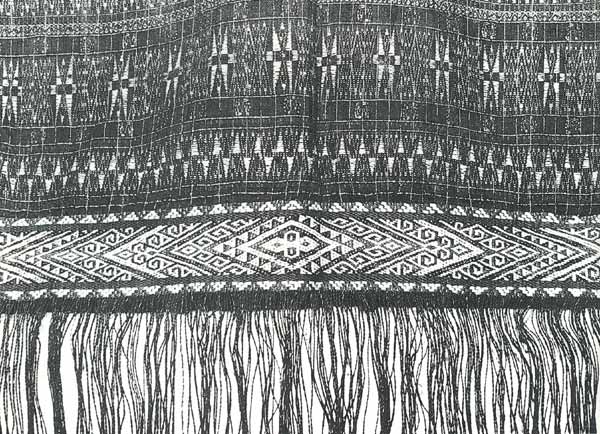
Page 58 Fig 76 A fine example of twining at the end of a Batak ragi hotang cotton textile
Page 58
A number of people, such as the Batak, Timorese, and Sumbanese, combine warp ikat with supplementary thread techniques to produce notable cloths.
Page 74.
The Batak woman heavy with her first child is presented, at the seventh month, with a special cloth (ragidup) called ulos ni tondi, or soul cloth. This textile is thought to have special protective powers from the accumulated life force of her lineage. The ulos ni tondi is worn at times of greatest vulnerability, such as childbirth or sickness. The cloth's protective power also extends to the woman's children.48 In preparation for an approaching birth, Javanese at one time celebrated the seventh month of pregnancy with a special ritual called Selamantan Tinkeban. A thread was wound around the mother-to-be's waist and cut by the father for the baby to 'emerge'. The baby, represented by a shuttle, was dropped from inside the woman's sarong, to be caught by the mother-in-law, who cradled it in a shawl. 49 Amongst the northern Tinguian of Luzon, a special white blanket, called an inalson, with blue and red warp stripes, was worn by a medium while celebrating the gipas rituals immediately prior to the birth of a child (Fig. 102). At the conclusion of the ceremony, this blanket was placed on the floor and covered with offerings to herald the birth. At the same time, the blanket offered proof to the spirits that all necessary formalities had been followed. 50.
Page 77
Courtship and Marriage
................. and the giving of the ragi hotang to a young couple by the bride's father is the high point in a traditional Batak wedding ceremony.
Page 78
The End of the Cycle
................ The Batak use blue and red ikat cloths as a cover for those lying in state. 92
Page 79
The End of the Cycle
............... The Batak, in keeping with their custom of giving textiles at rites of passage, present a special ritual cloth, the sibolang, a pale indigo to black cloth with zones of closely spaced warp ikat patterns, which for mourning is worn on the head (see Fig. 219).98
Pages 178-180
Central Sumatra
The Batak, a fiercely independent people numbering approximately three million,
farm the fertile valleys of the interior uplands adjacent to Lake Toba in north-central
Sumatra, and produce noteworthy textiles. In comparison with coastal silks,
Batak cloths are very subdued and understated from an aesthetic point of view.
They are of great ritual and social importance in rites of passage and in reaffirming
social relationships. Batak cloths, called ulos, which may be worn
as sarongs, shoulder cloths, or headcloths (Fig. 217), are usually woven in
a plain weave in sombre blue-black, rust, or maroon shades, sometimes enlivened
by pale stripes and/or bands of simple warp ikat consisting of small dashes,
simple rhombs, and arrowheads. Finely woven supplementary weft patterns often
adorn the ends and parts of the centre field. Beads also decorate some Batak
textiles. The ends of some ulos are finished with finely twined borders in geometric
designs. Formerly, hand-spun yarns and natural dyes were used. These have
now been largely replaced by commercial thread and chemical dyes. In the more
remote villages on Samosir Island in Lake Toba, it is still possible to observe
women weaving on body-tension looms anchored to the front of the house.
Over two dozen types of Batak textiles have been documented. One of the best known is the ragidup, which is woven by the Toba Batak who live on the southern shores of the lake. The ragidup is an approximately 200 cm by 100 cm length of cloth, composed of a warp ikat-patterned or striped central panel, linked at each end to an interlocking length of white cloth (pinar halak) embellished by horizontal bands of very finely woven geometric patterns in a supplementary weft. Motifs depicted on the pinar halak include stylized representations of the water beetle, centipede, teeth, and human figures. Strips of black cloth sewn along the selvages of the central panel and pinar halak complete the textile. This cloth is regarded as protective and may be given to a woman by her family during the last stages of her pregnancy (Fig. 218). The supplementary patterns which vary slightly on the pinar halak, have a 'male' and 'female' end. These patterns are thought to contain information pertaining to the future and may be interpreted by a knowledgeable elder or shaman, called a dukun. I5
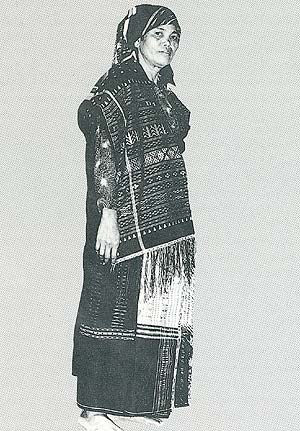
Fig 217.Batak woman
from Tomok, Samosir Island, in traditional dress. She is wearing an ulos
ragidup as a sarong, a beaded ulos sadum as a shawl, and an ulos
mangiring as a head-cloth
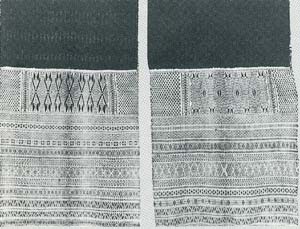
Fig 218 Batak ulos ragidup, showing detailed geometric supplementary weft patterns at the pinar halak. 'Male' designs are depicted in the centre panel of the pinar halak (on the left) while 'female' designs are depicted on the right.
The Toba Batak also weave the ragi hotang, which consists of a single strip of cotton in a warp-faced weave. A blue-black central zone, contained within a reddish brown band along the lateral edges, is patterned with numerous narrow white warp stripes and light flecks of warp ikat which are thought to imitate the rattan plant, a symbol of longevity to the Batak. The warp ends of the cloth are finished with small bands in geometric supplementary weft, followed by an elaborate twined border. The ragi hotang is presented by the bride's father to the bridal couple at the wedding ceremony. 16
A sombre textile of pale blue or black patterned with up to five bands of whitish blue ikat, called sibolang, is very important in gift exchanges during rites of passage (Fig. 219). On rare occasions it is given in lieu of a ragidup or ragihotang in certain ceremonies. The sibolang may be presented by the bride's parents to the groom's father and to their daughter when she marries. It is an important cloth presented to in-laws when there is a death in the family. It is also the main cloth that a widow receives from her mother at the time of bereavement. During the mourning period, this cloth is worn on the head rather than around the waist.
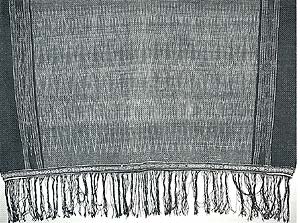
Fig 219. The sibolang, an important Batak ritual textile, which is blue or black in colour and patterned with bands of whitish-blue ikat. It is finished with twining. Warp 250 cm, weft 116 cm. Collection of Mrs James Simandjuntak, Jakarta.
The mangiring is a maroon rectangle of cloth measuring approximately 150 cm by 70 cm. The selvages are white followed by a wide plain maroon band on each side. The central area has small pinstripes in different colours. Some of these are decorated with small arrowheads in white warp ikat (Fig. 220). The mangiring serves as the ulos parompa (carrying cloth) presented by the maternal grandparents on the birth of their daughter's first child. It is also used as a head-cloth on festive occasions. 17
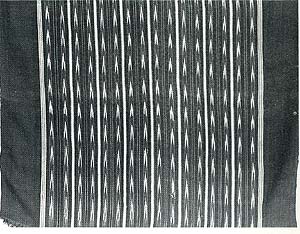
Fig 220. The ulos mangiring, a maroon rectangle of cloth decorated with pin stripes and arrow heads in warp ikat. Warp 165 cm, weft 77 cm
The Angkola Batak weave a distinctive festive looking textile called the sadum. If it has two panels, the sadum may serve as a garment or ulos godang in a gift exchange. A smaller version, called the parompa sadum, is used as a ceremonial baby carrier. The sadum is patterned with horizontal rows of rhomb-shaped, brightly co loured supplementary weft patterns in a plain warp faced or twill weave on a maroon or black foundation. There may also be a little tapestry weave in wool yarns. Small bead patterns sometimes appear throughout the textile and may be heavily concentrated along the warp edges at the ends of the cloth. Salutations and greetings may be also worked into the textile.I8 With the current penchant for brighter colours amongst the Batak, the sadum is being imitated by other groups. Influenced by their coastal neighbours, supplementary metallic threads have also crept into some Batak weaving (Fig. 221).

Fig 221. A Batak
parompa sadum cotton textile which is decorated with beaded designs
in many colours. Collection of Mrs James Simandjuntak, Jakarta.